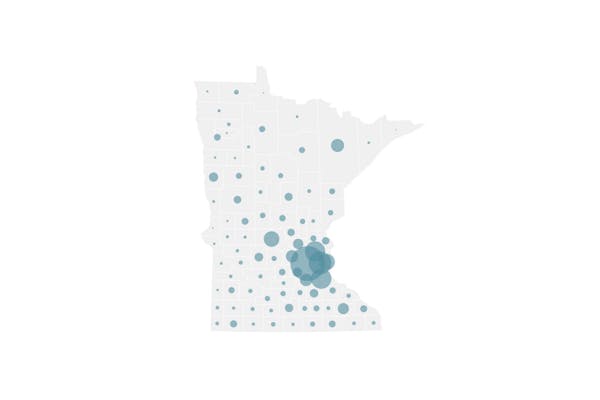State health officials Friday urged college-bound students to "lay low" in the two weeks before returning to campus to avoid bringing COVID-19 along with their mini-fridges and futons.
Informal isolation for two weeks — the typical incubation period for COVID-19 — will increase the odds that students arrive on campus virus-free and that colleges can maintain in-person classes, said Kris Ehresmann, state infectious disease director.
"No matter what you have been doing up to this point, now is a very important time to start reducing any activities that carry a heightened risk of transmission," she said. "That means skipping the massive house party, avoiding the crowded bars, and limiting your interactions."
The data suggest this will require broad behavior changes, as teens and young adults have fueled growth this summer in lab-confirmed infections of the coronavirus that causes COVID-19.
The Minnesota Department of Health on Friday reported 1,693 COVID-19 deaths and 63,723 lab-confirmed infections — with 38% of those infections involving people 29 and younger — since the first case in Minnesota was reported in March.
Confirmed infections among youths aged 6 to 19 have tripled to 7,704 since June 1, with health officials tracing outbreaks to large parties, tubing outings and other events.
Bars and restaurants have been sources of outbreaks, especially where visitors have been allowed to crowd together without wearing masks.
The state has found that more than 1,000 people were likely infected when visiting 47 establishments, including bars near campuses in Minneapolis and Mankato.
Minneapolis has since closed bars due to the recent uptick in COVID-19 cases. While teenagers and young adults are at relatively low risk — only five deaths have involved people 29 and younger — their mobility makes them risks for spreading the virus to others who are more vulnerable.
People 70 and older make up only 9% of all cases but 80% of the deaths.
Gov. Tim Walz closed bars as part of a statewide shutdown this spring, then allowed them to open June 10 with social distancing rules and limited indoor capacities.
While discussion in his administration continues on whether to close bars again — as happened in states such as California after COVID-19 activity rebounded — there are no such plans at this time.
The exact direction of the pandemic in Minnesota is unclear. The state reported rapid growth in confirmed infections in July, but that has leveled off a bit in August.
Hospitalizations have remained steady — with 313 COVID-19 cases being admitted as of Friday, and 152 requiring intensive care — but daily death counts have only been in the double digits on one day since July 2.
Whether people have long-term immunity after COVID-19 is unclear. However, the U.S. Centers for Disease Control and Prevention updated its guidance earlier this month and declared for the first time that people probably don't need to quarantine themselves if exposed to the virus within three months of prior COVID-19 illness unless they develop new symptoms.
Ehresmann said the new recommendation for students to isolate themselves will make college and university response plans more effective.
"Our goal is to minimize what is being brought onto campus," she said.
The health department published new guidance Friday for colleges and universities to adjust their prevention strategies if COVID-19 levels increase on their campuses.
Substantial changes to campus life would be encouraged, according to the guidance, if more than 3% of students tested positive for infections in a two-week period; if more than 75% of available quarantine beds on campus were full; or if there was general disregard among students for mask-wearing and social distancing.
Changes also would be considered if the local counties had infection rates above 30 per 10,000 people per 14 days. The rate in Hennepin County right now is 23.
In those scenarios, changes could include cancellation of extracurricular activities, on-campus diagnostic testing and campus curfews, according to the state guidance.
The University of Minnesota in Minneapolis and the University of St. Thomas in St. Paul are starting the fall with a mix of in-person and online education. Campus facilities such as cafeterias and fitness centers will be open, and they will be organized to promote social distancing and one-way traffic to reduce virus transmission opportunities.
A stay-at-home strategy before returning will help prepare students for campus life amid COVID-19, said Madonna McDermott, executive director for the Center for Well-Being at St. Thomas.
"It is a way to get used to the new normal that they probably will be experiencing when they come back to campus," she said. "There won't be large gatherings and there won't be large parties. Students will still be getting together, but on a much smaller scale."
Despite the perception of wild college students making rash choices, McDermott said she anticipated compliance among students who have already practiced mask-wearing and social distancing. They also have the motivation, after months of boredom at home, of knowing that compliance will reduce the spread of the virus, allow them to stay at college and protect others.
"They do care about other people," she said.
The U this week sent notices to students asking them to monitor their potential exposure to COVID-19 in the two weeks before returning to campus and to avoid large group gatherings.
Jeremy Olson • 612-673-7744

Trail section at one of Minnesota's most iconic spots closing for rehab

Will 'shotgun only' zone for deer in southern Minnesota be abolished?

Four Minnesotans catch salmonella in outbreak linked to basil sold at Trader Joe's

